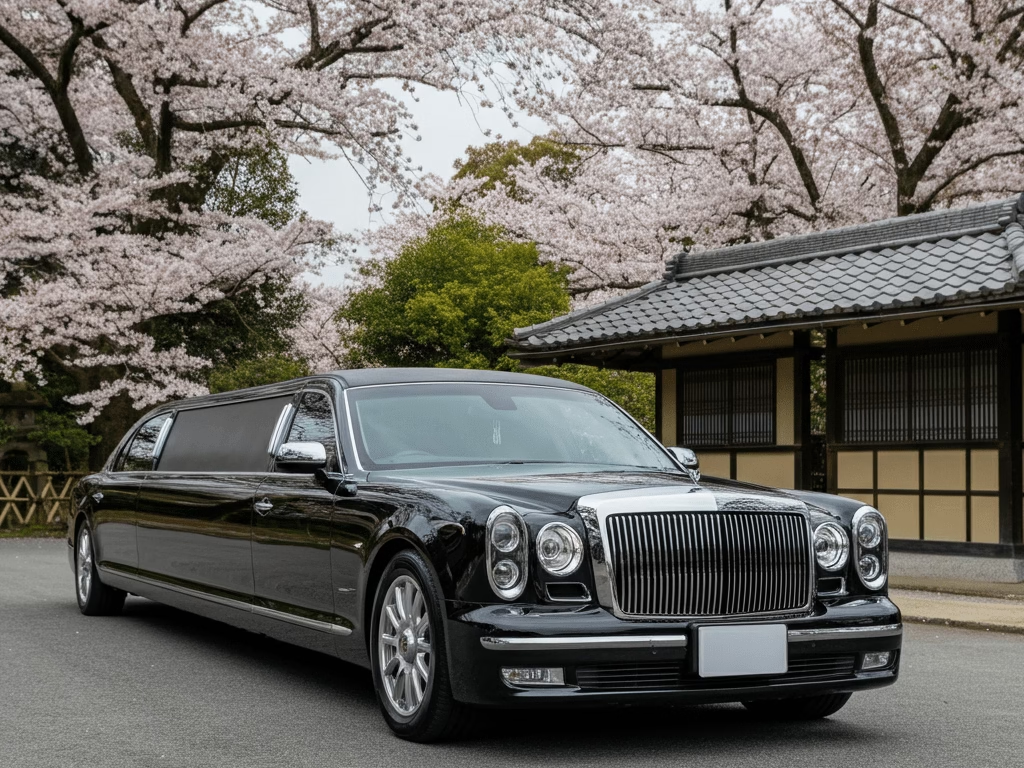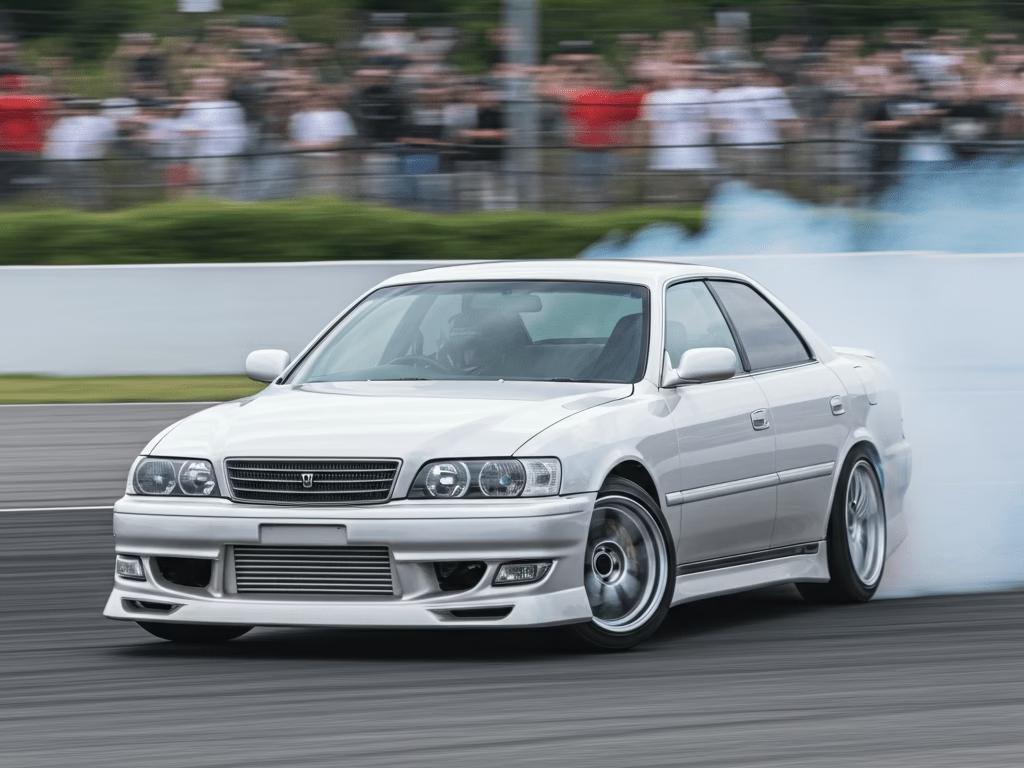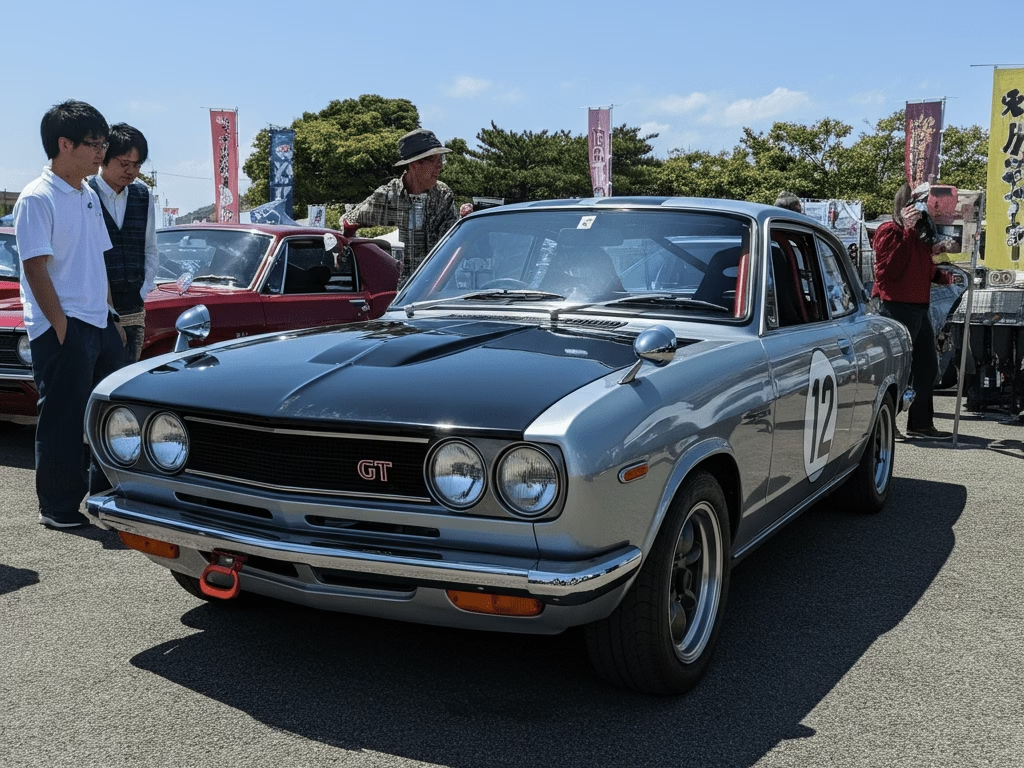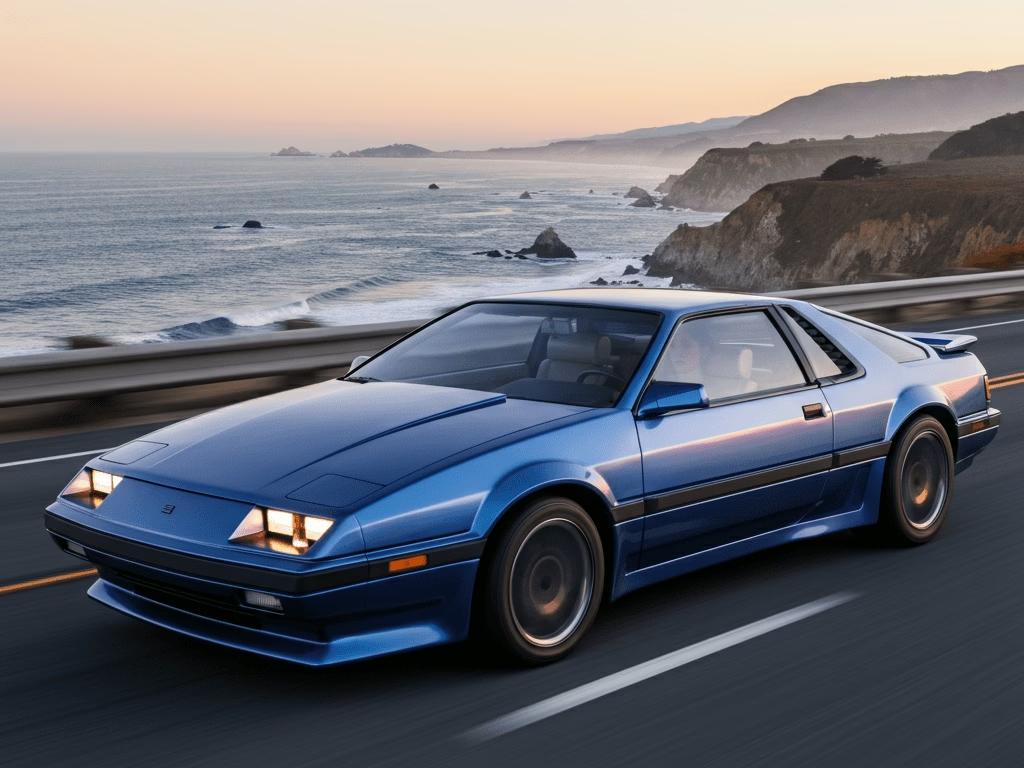Viewed from this perspective, the expression “muscle car” calls to mind images of rumbling American V8s Mustangs, Camaros and Chargers.
For decades in the United States, big engines and straight-line performance defined the muscle car.
However, while American muscle followed a familiar path, Japan was creating its own interpretation of high-performance JDM Muscle.
Table of Contents
Although Japanese cars became known for lightweight, high-revving engineering, they also produced vehicles with impressive power, bold aesthetics, and thrilling driving experiences.
These were unique, performance-driven machines, distinct from their American counterparts but no less significant.
This article will clarify what sets JDM Muscle cars apart, exploring 8 key facts that offer insight into their engineering and enduring appeal.
Following American examples, Japan set its own mark in high-performance vehicles. Did you know Japan has built a V12 “hot rod”? Many associate a V12 with gleaming Italian supercars like Ferrari or Lamborghini.
So, it may come as a surprise to learn that Toyota traditionally known for practical, efficient cars is the only other automaker besides Italy to offer a twelve-cylinder engine.
This engine didn’t appear in a sleek sports car but found its home in Toyota’s ultra-luxurious Century estate car.
1. The Toyota Century Japan’s Secret V12 Muscle Limo

The Century is the vehicle of choice for the Japanese royal family, as befits its size and stature.
Beneath its piano-black lacquered hood lies a unique 5.0-liter, 48-valve V12 engine Toyota’s 1GZ-FE.
Despite a “Gentleman’s Agreement” limiting official power to 276 horsepower, this engine is widely believed to exceed 300 horsepower.
Factory equipment, such as specially-developed Pirelli tires, addressed early handling challenges for these hand-assembled luxury sedans.
This combination makes the Century a prime example of JDM Muscle a grand tourer disguised as a limousine.
Aftermarket tuners have coaxed over 1,000 horsepower from the 1GZ-FE, cementing its reputation among performance enthusiasts.
The Original “Godzilla” The Hakosuka Skyline GT-R

Before today’s R32 Skyline GT-R earned the “Godzilla” nickname for dominating Australian motorsport and making waves in international media, its predecessor different in style but equally revered laid the foundation of this iconic lineage.
In 1969, the original Skyline GT-R debuted. Nicknamed the “Hakosuka” from hako (box) and suka (Skyline) it was a key pioneer of JDM Muscle.
Prior to Nissan’s acquisition, Prince Motor Company expanded on race car technology to develop the first GT-R for homologation, equipping a modest sedan with Nissan’s advanced S20 engine.
This 2.0-liter engine delivered 160 horsepower a remarkable achievement in 1969. The Hakosuka’s victories on Japanese racetracks culminated in its biggest triumph winning the 1969 touring car championship.
- The Hakosuka GT-R wasn’t for show : stripped down to essentials, it was a purpose-built tool of one goal: winning races. And win it did.
- Dominant Performance: Holding this record is the four-door PGC10, turned out as clay by Sakita Rally and later the two-door KPGC10 that achieved, what still stands today as a towering and undefeatable record in Japanese touring car races, of 50 consecutive wins, three seasons.
- High-Revving Power: Unlike American muscle car V8s, whose big charms lay in their low-revving torque, the S20 engine’s peak power comes at a thrilling 7,000 RPM, like a racing car.
- Lightweight Philosophy: The Hakosuka embodied the emerging JDM Muscle ethosbalanced handling and high power-to-weight ratio ensured agility, control, and speed.
The Hakosuka established the GT-R as a performance icon, a heritage of wild power which would live on in the Skyline for generations to come.
The Mitsubishi Galant VR-4 The AWD Rally Monster in a Suit

In the late 1980s, Mitsubishi aimed to win the World Rally Championship (WRC). To do this, it needed a production car for its rally racer.
The answer was the Mitsubishi Galant VR-4 an ordinary family sedan hiding a rally-beaten monster under its demure skin.
The sixth-generation Galant VR-4 was a technical tour de force, an excellent example of sophisticated JDM Muscle.
It combined three major factors of high performance:
- The 4G63T Engine: This legendary 2.0-litre turbocharged inline-four engine was later to be found in the Lancer Evolution series. In the Galant VR-4 it turned out around 237 bhp, a huge figure for its time.
- What is the VR-4? :- The acronym signified “Viscous Realtime Four Wheel Drive.” This AWD system provided remarkable traction, so that wherever you were driving your turbocharged monster of a car regardless of conditions or terrain everything was kept firmly on the ground and actually going in the direction intended by its driver.
- Four-Wheel Steering: Many cars also came with this technology, which offered improved high-speed handling and easier driving at low speeds; the result was an unusually lively, responsive vehicle considering how big it was
The Galant VR-4 appealed to enthusiasts who valued both intelligence and muscle it could outperform sports cars on twisting roads or slippery surfaces, all while offering comfort for four passengers.
The Galant set the stage for the Lancer Evolution, yet stands alone as a pioneering machine, bringing WRC technology to everyday driver experiences.
The Toyota Chaser JZX100 The Four-Door Supra

Though the Toyota Supra with its 2JZ-GTE engine is celebrated all over the world, many enthusiasts have never even heard of its four-door relative, the Toyota Chaser JZX100. Only sold in Japan, these cars (together with their relatives the Mark Ⅱ and Cresta) shared the heart of the great Supra but came in practical sedan form.
This gave you the ultimate JDM sleeper.
With later models featuring VVT-i (Variable Valve Timing with intelligence), the 1JZ engine earned a reputation for being robust and powerful officially rated at 276 horsepower, but truly capable of much more.
Its strong torque and tunable design made it a favorite in drift communities. The Tourer V with the 1JZ-GTE engine remains among the most desirable combinations for performance and reliability.
The JZX100 Chaser was more than a sedan with a powerful engine it successfully merged daily practicality with spirited performance.
With its comfortable interior for five and generous trunk space, the Chaser served as a true sleeper.
When pushed, it transformed into a tire-shredding machine, capturing the evolving spirit of JDM Muscle.
The Gentleman’s Agreement The Truth Behind 276 Horses

One of the most fascinating and little-known features of the golden age of JDM Muscle is the “gentleman’s agreement.”
In 1989, the Japan Automobile Manufacturers Association (JAMA) voluntarily agreed to cap the advertised horsepower for all new cars sold in Japan at 280 PS (276 hp).
This was ostensibly for safety’s sake, in order to prevent a domestic horsepower war.
However, the agreement was more a guideline than a hard and fast rule. While manufacturers advertised their cars at or just under the 276 horsepower limit, actual engine output was often far higher.
This was an open secret to aficionados as well as the motoring press. Cars such as the Nissan Skyline GT-R R34, Mazda RX-7 and Toyota Supra all appear in the records with 276 hp, but their true capacity straight from the factory is more like 320-330 hp.
This agreement has had a profound effect upon the nature of JDM Muscle cars:
- Over-Engineered Powerplants: With advertised horsepower figures as a common limit that could not be exceeded their goal became massive tuning potential and indestructible engines. All the engineers knew that the customer would eventually release this true power for themselves.
- Focus on Torque and Drivability: Engineers paid attention to building torque and response over entire rpm bands, rather than just the peak horsepower figures. The result was cars that were powerful and interesting to drive over their full revel range.
Inadvertently, the output and setting of the Gentleman’s Agreement helped fuel Japan’s vibrant aftermarket tuning culture.
The “detuned” nature of these engines made them the perfect canvas for modification.
The Gentleman’s Agreement officially ended in 2004, but it left behind a legacy of incredibly durable and tunable engines that once defined JDM Muscle era after another in Japan.
You can find out more about the specifics of this period of time from road track websites specializing in automotive history.
The Isuzu Bellett GT-R A Forgotten JDM Pioneer

When you think of Isuzu, the name probably calls to mind commercial trucks or practical SUVs like Trooper.
But in the 1960s, Isuzu was a player on Japan’s performance scene and they made one of Japan’s first true JDM Muscle cars the Bellett GT-R.
Made in 1969, the same year as the Hakosuka Skyline, the Bellett GT-R (or GT-Type R) was a race-homologated special.
Isuzu took their compact Bellett coupé and gave it a big go-fast treatment.
Out of race car maker T-C-S-C the people who developed this 1.6-liter DOHC inline four cylinder engine which produced a very healthy 120hp.
Though that number might seem small for now, in 1969 this was much power for a light, little car. And the Bellett GT-R boasted:
- A black hood with two silver racing stripes down it.
- Upgraded suspension and brakes to cope with its extra power.
- A close-ratio 4-speed manual gearbox.
A fierce competitor on the track, the Bellett GT-R often rubbed fenders with the more famous Skyline GT-R.
Its success in motorsport showed even a smaller carmaker could make a car with big performance heart.
Though fewer than 1,500 were ever made, the Bellett GT-R is an important, if largely overlooked, piece of JDM muscle history.
The Toyota Soarer Z20 The Digital Performance Cruiser

The 1980s were an age of technical optimism in Japan, and no car captured this mood better than Toyota’s second-generation Soarer (Z20).
It was a luxurious personal coupe that transformed some of its period’s most cutting-edge technology into JDM Muscle performance.
The top of the range model, the 3.0GT Limited, used the 7M-GTE engine, a 3.0-liter turbocharged six that made 232 horsepower and a wad of torque equivalent to burnsides notorious for G forces numeric value.
This was the same engine that powered the Supra A70, but in the Soarer it came wrapped in a package of futuristic luxury.
In 1986, the list of Soarer tech features was simply staggering:
- Electronically Controlled Air Suspension: This system had adjustable ride height and damping, allowing the driver to switch between a soothing cruise and sportishly stiff settings at the flick of a wrist.
- Digital Dashboard: A full-color digital instrument display showed the driver a futuristic smorgasbord of speed, RPM and vehicle information.
- Touchscreen Controls: The “Electro Multivision” part of course was a touch screen that ran the climate, audio, and vehicle functions a feature which would not become common for another twenty years.
The Soarer Z20 was JDM Muscle for the digital age. It demonstrated that high performance and gentleness did not have to be mutually exclusive.
It could be both high-tech, comfortable and crammed full of state-of-the-art kit. For a generation to come following that one, it set the template for touring coupes.
The Nissan Stagea 260RS Autech A Wagon Version of the GT-R

Image the performance of a Nissan Skyline GT-R R33, but with rear seats large enough for your dog, air-suspension bags and a spare set of wheels.
Please allow me to introduce the Nissan Stagea 260RS Autech, manufactured in the traditional sense of Autech (Nissan’s “in-house tuner”), and after refinement at its shop (ie. tuning factory) this car has got to be one of Japan’s best things when it comes to factory-tuned JDM Muscle
Autech Bill, a modified version of Nissan’s all-wheel-drive Stagea station wagon, was taken over by a younger son in the family None other than the GT-R’s drive train including transmission and rear diff
260 RS was no mere engine swap; it was a complete GT-R drivetrain transplant. The car received:
- The RB26DETT Engine: The famous 2.6-liter, six-cylinder, twin-turbo engine petrol unit which powered the GT-R Skyline.
- The ATTESA E-TS AWD :- (Advanced TheGT-R’s high-tech all-wheel-drive system with electronically controlled traction) system: It provided unmatched cornering ability and grip.
- A 5-Speed Close-Ratlo Manual Transmission: A good solid manual gearbox lets you control all that power from the GT-R engine
- GT-R Suspension and Brakes: The wagon was reinforced, and it was equipped with the GT-R ‘s suspension parts and Brembo-brand brakes to handle the extra power.
The result was a five-door family wagon that could accelerate and corner with cars costing three times its price.
It was the definitive sleeper; something that could eat supercars for breakfast, yet remain completely practical to use every day.
Stagea 260 RS Autech is perhaps JDM Muscle’s ultimate example hidden by a veil of false modesty, a car that combines utility with earth-shattering performance in a single unit.
For more detailed specs on these cars, enthusiast sites like MotorTrend often provide deep dives.
The Legacy of JDM Honkers From V12 luxury four-doors and rally-bred Family sedans, to coupe-type commuter coupes
The parade of vehicles in scenes that in the air because wind softening can’t keep up with all sorts of directions on topaz mines is no mere stereotype.
These cars represent a unique lifestyle. A jewellery craftsman equal to none and the first generation entrepreneurs who raced in boots they had assembled themselves, had created with their engineering prowess, driving passion a willingness to hide such incredible power in plain sight the most famous machines of automotive history.
These cars may not have a symphony of V8 rumble like their American cousins, but they’ve got something an essence, synthesis, and performance metrics that earns them a place among muscle cars while still separate from them.
When you next see one of these legends on the road, remember that each is a little piece of JDM Muscle haps worth.
Frequently Asked Questions about JDM Muscle
What does “JDM Muscle” mean?
JDM Muscle refers to high performance cars from Japan’s domestic market, but which have the independent spirit of American muscle cars. While they do not boast huge V8 engines, these cars concentrate on powerful performance, a strong presence on the road, and an exciting drive. Often they have advanced turbocharged straight six or four‐cylinder engines.
How are JDM Muscle cars compared to American muscle cars?
Neither is definitively “better”they are different approaches to performance. American muscle typically relies on large-displacement V8 engines for massive torque. By contrast JDM Muscle often makes its power through smaller but technologically advanced high-revving engines, advanced all-wheel-drive systems and emphasizing power-to-weight ratio.
What is the “Gentleman’s Agreement” in the history of Japanese cars?
The Gentleman’s Agreement was a voluntary pact among japanese car manufacturers from 1989 to 2004 to limit advertised horsepower of their cars to 280 PS (276 hp). This was done in order to avoid a domestic “horsepower war”. Nevertheless many cars like the Skyline GT‐R and Toyota Supra were actually much more powerful fresh from the factory.
Did Toyota ever really make a V12 engine?
Yes, Toyota produced Japan’s only production V12 engine, the 1 GZ ‐FE. This 5.0‐liter V12 was put not in a sports car but in the ultra-luxurious Toyota Century limousine, making it a surprising example of “sleeper” JDM Muscle.
What is a “Hakosuka”?
“Hakosuka” is the nickname for Nissan’s first-generation Skyline GT‐ R, made from 1969 to 1972. The name is a combination of the Japanese words for box (hako) and skyline (suka). It is considered the original JDM Muscle car and dominated Japanese touring car racing.
Can a station wagon ever become JDM Muscle?
Absolutely. The Nissan Stagea 260RS Autech is a prime example. It’s station wagon that came straight from the factory with engine and all-wheel drive system of the legendary Nissan Skyline GT-R R 33, making it effectively a “GT-R wagon” and the ultimate performance utility vehicle.
So what could make cars like the Toyota Chaser JZX100 so popular?
The Toyota Chaser JZX100, as well as its Mark II and Cresta siblings, are known for offering performance similar to that of the Toyota Supra but in a more practical four-door sedan body. It features the potent and highly tunable 1JZ-GTE twin-turbo engine, which makes it a favorite in the drift and tuner communities.











[…] ever cruised through car meets or scrolled through social media car pages, the term ” What Does JDM Stand For ” probably caught your […]